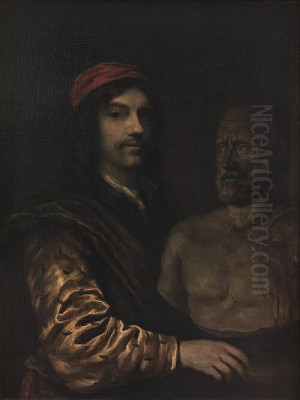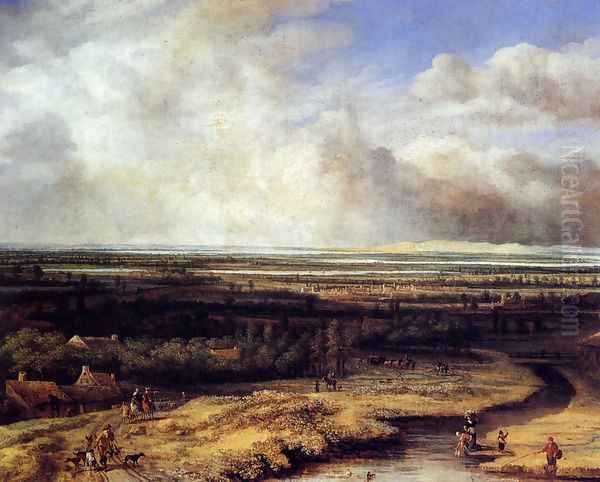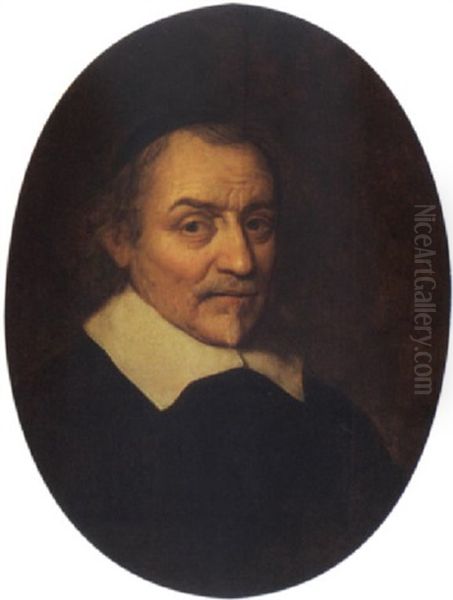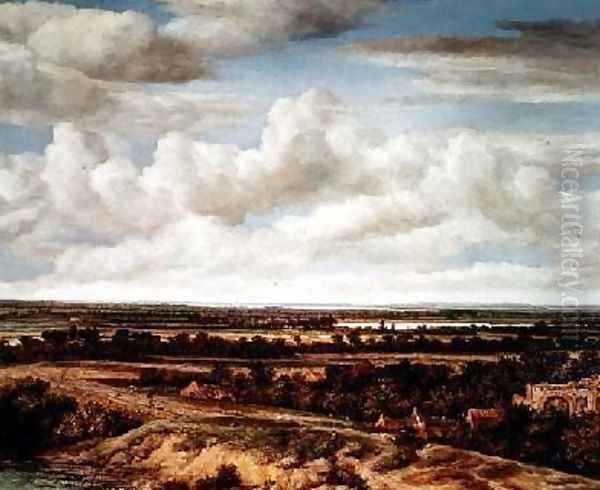
The Dutch Golden Age, spanning roughly the 17th century, was a period of extraordinary artistic flourishing in the Netherlands. Amidst the burgeoning wealth derived from trade and exploration, a unique market for art developed, catering to the tastes of a prosperous merchant class. While portraiture, genre scenes, and still life painting reached unprecedented heights, landscape painting emerged as a particularly beloved and distinctly Dutch genre. Within this vibrant artistic milieu, Philips Koninck (1619-1688) carved out a significant niche for himself, becoming one of the most celebrated masters of the panoramic landscape. His expansive vistas, imbued with atmospheric depth and a profound sense of tranquility, capture the essence of the Dutch countryside and stand as enduring testaments to the Golden Age's artistic achievements.
Early Life and Artistic Beginnings
Philips Koninck was born in Amsterdam in November 1619. He hailed from an artistic family; his father, Aert de Koninck, was a respected goldsmith. Philips was the youngest of six sons. His initial artistic training came not in Amsterdam, however, but in Rotterdam. Around 1637, he began studying under his elder brother, Jacob Koninck I, who was an established painter active in that city. This apprenticeship lasted for approximately three to four years, likely concluding around 1640 or 1641.
This early training under Jacob would have provided Philips with a solid foundation in the techniques and conventions of Dutch painting. Jacob himself painted landscapes and genre scenes, and while his style differed from the grand panoramas Philips would later develop, the fundamental skills of composition, colour mixing, and brushwork were undoubtedly honed during this period in Rotterdam. The experience outside the immediate artistic hub of Amsterdam may also have exposed him to different regional styles or influences early in his career.
Return to Amsterdam and Establishing a Career

By 1641, Philips Koninck had returned to his native Amsterdam, the bustling centre of Dutch commerce and culture. This move marked a pivotal moment in his life and career. In January of that year, he married Cornelia Furnerius, who belonged to the Furnerius family, possibly connecting him further within the artistic community. Her brother (or relative), Abraham Furnier, was also associated with the circle of artists around Rembrandt. Koninck would remain based in Amsterdam for the rest of his life, establishing himself both as an artist and a businessman.
Settling in Amsterdam placed Koninck at the heart of the Dutch art world. He entered a competitive but stimulating environment populated by some of the era's greatest talents. It was here that his artistic identity truly began to form, moving beyond his initial training towards the distinctive style that would define his legacy. The city offered numerous opportunities for patronage, artistic exchange, and exposure to the latest trends and innovations in painting.
The Enterprising Artist: Business and Art
Interestingly, Philips Koninck did not rely solely on painting for his livelihood. He was also a successful businessman, operating a shipping service that ran between Amsterdam and Rotterdam. This enterprise appears to have been quite profitable, providing him with a significant degree of financial security throughout his life. In his later years, records indicate he also served as a guardian or overseer for ships, suggesting continued involvement in maritime commerce.
This financial independence likely afforded Koninck considerable artistic freedom. Unlike many contemporary artists who were heavily reliant on commissions and the fluctuating demands of the art market, Koninck could pursue his artistic interests with less immediate economic pressure. This may have contributed to his ability to specialize in the relatively demanding genre of large-scale panoramic landscapes, which might not always have found ready buyers compared to smaller, more conventional scenes or portraits. His dual career highlights the multifaceted lives led by many individuals during the Dutch Golden Age, where artistic pursuits often intertwined with mercantile activities.
Koninck and the Sphere of Rembrandt
One of the most discussed aspects of Philips Koninck's career is his relationship with the towering figure of Dutch art, Rembrandt van Rijn (1606-1669). While historical sources confirm a close connection, the exact nature of this relationship remains nuanced. Koninck is generally considered to have been a friend and associate of Rembrandt, rather than a formal pupil who spent years registered in his workshop. However, there's strong evidence, particularly in Koninck's work from the 1640s onwards, to suggest he spent time absorbing the master's techniques and artistic vision, possibly working within Rembrandt's studio environment for a period.

The influence of Rembrandt is palpable, especially in Koninck's handling of light and shadow (chiaroscuro), his compositional strategies in certain historical or religious subjects, and the atmospheric depth found even in his landscapes. Rembrandt himself produced a small number of highly influential landscape paintings and etchings, often characterized by dramatic lighting and expressive brushwork. Koninck adapted these elements, translating Rembrandt's dramatic intensity into the expansive, light-filled calm of his own panoramic views. His figures, when they appear in his landscapes or in his portraits and genre scenes, also sometimes echo Rembrandt's style.
It is important to distinguish Philips Koninck from his slightly older contemporary, Salomon Koninck (1609-1656), who was also an Amsterdam painter active in Rembrandt's circle and whose works sometimes share stylistic similarities, occasionally leading to confusion in attribution. Philips, however, developed a much more distinct and renowned specialization in landscape.
Forging the Panoramic Vision
While influenced by Rembrandt, the defining characteristic of Philips Koninck's oeuvre is his mastery of the panoramic landscape. This genre, depicting vast, expansive views often seen from an elevated viewpoint, had precedents in Dutch art, notably in the innovative and often experimental works of Hercules Segers (c. 1589/90–c. 1638). Segers's imaginative and often hauntingly empty vistas pushed the boundaries of landscape representation. Another significant influence was Jan van Goyen (1596-1656), a prolific painter known for his atmospheric, often tonal landscapes that captured the flat, water-logged Dutch countryside under expansive skies.
Koninck synthesized these influences and developed his own unique formula. His typical composition features a high vantage point, looking out over a wide, flat terrain that stretches towards a distant horizon. The sky dominates the canvas, often occupying two-thirds or more of the picture plane. This vast expanse of sky is rarely empty; Koninck excelled at depicting cloud formations, using the interplay of sunlight breaking through clouds and the resulting shadows moving across the land below to create dynamism, depth, and mood.
His landscapes are not usually topographically exact representations of specific locations but rather composite views, evoking the characteristic features of the Dutch countryside – flat fields, winding rivers, distant villages nestled among trees, and the ever-present, dramatic sky. The effect is one of immense space, tranquility, and a subtle, almost spiritual connection to the land. He achieved this through careful composition, a sophisticated understanding of aerial perspective (where colours become cooler and details softer in the distance), and a masterful handling of light.
Colour, Light, and Atmosphere

Koninck's colour palette plays a crucial role in establishing the mood of his landscapes. He often employed a warm range of colours, particularly yellows, golds, browns, and ochres, especially in the foreground and middle ground, suggesting sunlit fields and earthy terrain. These are balanced by the cooler blues, greys, and whites of the expansive sky, and often punctuated by the soft greens of foliage and the silvery blues of water.
His treatment of light is particularly noteworthy. Unlike the often dramatic, focused chiaroscuro found in many of Rembrandt's works, Koninck's light is typically more diffuse and pervasive, bathing the landscape in a gentle glow. The real drama comes from the patterns of sunlight and shadow cast by the clouds, which articulate the contours of the land and guide the viewer's eye through the vast space. This dynamic interplay creates a sense of movement and fleeting atmospheric conditions, making the landscapes feel alive and immediate, despite their stillness. The overall atmosphere is one of serene grandeur, a peaceful yet majestic vision of the natural world.
Representative Masterpieces
Several paintings stand out as prime examples of Philips Koninck's mature style. An Extensive Landscape with a Hawking Party (c. 1665-1670), housed in the National Gallery, London, exemplifies his approach. From a high viewpoint, the viewer looks across a vast plain intersected by rivers and dotted with small settlements. Cloud shadows dapple the landscape, creating patterns of light and dark that lead the eye towards the low horizon. The sky is immense, filled with subtly rendered clouds. Tiny figures engaged in a hawking party in the foreground serve to emphasize the immense scale of the surrounding nature.
Another iconic work is An Extensive Landscape with Houses in the Distance (c. 1664), located in the Metropolitan Museum of Art, New York. This painting showcases his characteristic composition: the high viewpoint, the dominant sky filled with rolling clouds, and the flat landscape receding into the distance. The warm, golden light illuminates patches of the land, contrasting with the cool shadows. The meticulous rendering of details in the foreground gradually softens towards the horizon, perfectly demonstrating aerial perspective. Works like these cemented Koninck's reputation as the preeminent painter of the Dutch panorama.
While landscapes dominate his known output and legacy, Koninck did produce other works. His Portrait of Joost van den Vondel (c. 1665), depicting the famous Dutch poet and playwright, demonstrates his capability in portraiture, capturing a sense of the sitter's intellectual presence, likely influenced by Rembrandt's portraiture style. This work is held by the Rijksmuseum in Amsterdam.
Beyond the Horizon: Other Artistic Pursuits
Although Philips Koninck is overwhelmingly celebrated for his landscapes today, during his lifetime, his reputation may have been more balanced across different genres. He painted portraits, as evidenced by the Vondel picture, and likely undertook other commissions for likenesses, a staple for many Golden Age artists.
He also engaged with genre painting – scenes of everyday life. An example is the Bacchus Party (c. 1650), reportedly painted for an artists' confraternity he was involved with, possibly the "Brotherhood of Artists" mentioned in historical records around 1654. Such works allowed artists to explore different themes, often incorporating allegory or moral commentary within seemingly informal settings.
Furthermore, Koninck tackled historical and religious subjects, though fewer examples survive or are securely attributed compared to his landscapes. These works would have drawn more directly on the influence of Rembrandt and other history painters, focusing on narrative, human emotion, and often employing more dramatic compositions and lighting than his serene landscapes. His involvement in these varied genres demonstrates a versatility common among successful artists of the period, even if landscape became his most personal and enduring contribution.
Koninck in the Context of the Golden Age
Philips Koninck occupied a distinct position within the rich tapestry of Dutch Golden Age painting. While Rembrandt was the dominant figure in Amsterdam, influencing countless artists, the era was marked by remarkable specialization. Koninck's specialization in the panoramic landscape set him apart.
His contemporaries included other great landscape painters, but their approaches often differed. Jacob van Ruisdael (c. 1628/29–1682), arguably the most versatile landscapist of the era, painted a wider variety of scenes, including forests, waterfalls, and seascapes, often imbued with a more melancholic or dramatic mood. Meindert Hobbema (1638-1709), Ruisdael's pupil, focused on charming woodland scenes, quite different from Koninck's open vistas.
Painters like Aelbert Cuyp (1620-1691) in Dordrecht became famous for their depictions of the Dutch landscape bathed in a warm, golden, almost Italianate light, often featuring cattle. Jan Both (c. 1618-1652) was a leading figure among the Dutch Italianates, who travelled to Italy and brought back a style characterized by idealized landscapes and warm Mediterranean light, contrasting with Koninck's focus on the specific atmospheric conditions of the Netherlands.
In Amsterdam itself, artists like Johannes Vermeer (1632-1675), though based in Delft, created meticulously composed interior scenes renowned for their handling of light and perspective – a different kind of spatial exploration compared to Koninck's expansive views. The portraiture market was vibrant, dominated by figures like Rembrandt and, earlier, Frans Hals (c. 1582-1666) in Haarlem. Genre painters such as Pieter de Hooch (1629-1684) and Jan Steen (c. 1626-1679) captured intimate or lively scenes of domestic life and social gatherings. Koninck navigated this complex world, interacting with peers, absorbing influences, and ultimately forging his unique path.
Later Years and Posthumous Reputation
Philips Koninck continued to paint throughout his life, although his most celebrated panoramic landscapes seem to date primarily from the 1650s and 1660s. He remained a respected figure in Amsterdam's artistic and business communities. He passed away in Amsterdam in October 1688 and was buried in the Zuiderkerk, a prominent church in the city.
Interestingly, while respected during his lifetime, the full appreciation of his unique contribution to landscape painting seems to have solidified later, particularly during the 19th century. As tastes evolved, the specific qualities of his panoramic views – their spaciousness, atmospheric subtlety, and evocative power – gained increasing recognition. Critics and art historians began to see him not just as one among many talented Golden Age painters, but as a singular master of a specific type of landscape vision. His works started commanding higher prices and became sought after by major collectors and museums across Europe and later, America.
This posthumous rise in stature is not uncommon for artists whose work might have been somewhat specialized or subtly innovative for their own time. The passage of time allowed for a clearer perspective on his achievements within the broader context of Dutch art history.
The Enduring Legacy of Philips Koninck
Philips Koninck's legacy rests firmly on his breathtaking panoramic landscapes. He took an existing format and refined it, creating images of unparalleled spatial grandeur and atmospheric nuance. His ability to capture the vastness of the Dutch sky and the flat expanse of the land beneath, all rendered with a delicate sensitivity to light and air, remains remarkable.
His influence on subsequent landscape painting may have been more subtle than that of figures like Jacob van Ruisdael, but his work stands as a pinnacle of one specific, powerful approach to depicting the natural world. He demonstrated how the seemingly unremarkable flatlands of Holland could be transformed into scenes of profound beauty and tranquility through artistic vision and technical skill.
Today, his paintings are treasured holdings in major international museums, including the Rijksmuseum in Amsterdam, the National Gallery in London, the Metropolitan Museum of Art in New York, the Getty Museum in Los Angeles, and the Statens Museum for Kunst in Copenhagen, among others. They continue to captivate viewers with their serene beauty and masterful execution, offering a window onto the landscape and the artistic sensibilities of the Dutch Golden Age. He remains recognized as one of the last great masters of 17th-century Dutch landscape painting.
Conclusion: A Visionary of the Dutch Vista
Philips Koninck stands as a significant figure in the history of art, a specialist who achieved mastery within his chosen domain. Emerging from the vibrant artistic environment of the Dutch Golden Age and navigating the influential sphere of Rembrandt, he developed a unique and compelling vision focused on the panoramic landscape. His paintings, characterized by their expansive scope, dominant skies, and subtle handling of light and atmosphere, offer more than just depictions of the Dutch countryside; they are profound meditations on space, nature, and tranquility. As both a successful businessman and a dedicated artist, Koninck embodies aspects of the Golden Age spirit, while his enduring artistic legacy confirms his status as a true master of the Dutch vista.